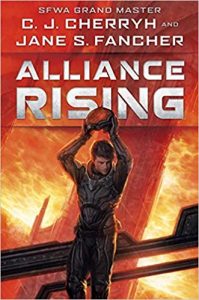Russell Letson Reviews Alliance Rising by C.J. Cherryh & Jane S. Fancher
 Alliance Rising, C.J. Cherryh & Jane S. Fancher (DAW, 978-0756412715, $26.00, 354 pp, hc) January 2019. Cover by Micah Epstein.
Alliance Rising, C.J. Cherryh & Jane S. Fancher (DAW, 978-0756412715, $26.00, 354 pp, hc) January 2019. Cover by Micah Epstein.
The title page of C.J. Cherryh and Jane S. Fancher’s Alliance Rising identifies it as “An Alliance-Union Novel,” part of the extensive common-background sequence that goes back to the beginning of Cherryh’s writing career. This particular segment of that sprawling future history belongs to the temporal and spatial neighborhood of the ten Company War and Cyteen volumes published between 1980 and 2009. As the title suggests, this is the story of the beginnings of the Alliance, a co-operative organization that binds together the Family-run merchant starships whose trade routes link and sustain the extrasolar stations – enormous habitats that live or die by what the merchants carry. Out among the stars, stationers and merchant Families have diverged culturally from each other and from the Earthly powers that built the earliest stations.
Those Earth authorities, in the form of the EC (the Earth Company) would love to extend their reach and exert control over all the activity in the near and farther stars, but those stations and planets are now tied together by faster-than-light travel, and the home solar system, lacking the jump points that enable FTL, is limited to sub-light travel and is locked out of most of this far-flung economy. As a result, stationers and merchanters tend to see the distant EC as overbearing, ignorant of the realities of interstellar trade and culture, and generally irrelevant.
The novel takes place almost entirely in the confines of Alpha Station, the oldest and closest to Earth of the stations, and the crisis is set off by the arrival of four FTL merchant ships that normally would not bother with this marginal, “bag-end” port of call. For years, Alpha Station operations have been strained materially and politically, thanks to directives from interloping administrators from EC, which has made Alpha the construction site for the Company’s ambitious FTL ship, the interestingly named Rights of Man. Worse yet, control of large parts of station management has been appropriated by the project boss and his security chief, neither of whom is station-born or even very sympathetic to the needs of Alpha and the handful of Family-run trading spacecraft that serve it.
We see this situation through three viewpoint characters: Alpha stationmaster Ben Abrezio, Finity’s End senior captain JR Neihart, and Family ship Galway trainee navigator Ross Monahan. For the greater part of the novel, their perceptions and understandings do not overlap very much, leaving the reader in a curiously privileged position, overhearing their thoughts but still limited to what these three can observe and figure out. Young Ross is in some ways the most interesting: clearly gifted (he is assigned to shadow his ship’s primary navigator) but untested, inexperienced, and unsure of himself. Fortunately his mentor is very senior, with a memory that goes back to pre-FTL days, so we get a seasoned Family sensibility at second hand. Abrezio is an able, decent, practical administrator stuck in a precarious position, encumbered by ambitious, true-believing bullies from the EC front office and worried about how to preserve his station and his career. Captain JR Neihart has the largest view of events and forces and the clearest agenda: to weld the 63 Family-run trading ships into a mutual-aid organization that asserts the sovereignty of each vessel and recognizes the interdependence of traders and stations. But nobody knows exactly what to expect from the EC – whether and when it will acquire FTL access to Alpha and beyond, and how it means to employ the suspiciously configured Rights.
Much space in the early chapters is necessarily given over to exposition of all kinds, economic, scientific, political, sociological, historical, individual; and that explanatory/exploratory urge continues to dominate much of the book, unpacking agendas and aspirations and visions while the actors assess each other, game out possibilities, prepare positions, and move assets into place. This is not a plotty book, but one about viewpoints and estimations of the motives and behavior of others. It is dominated by meetings and conversations and is dense with reactions, reflections, considerations, estimations, aspirations, and second-guesses, always conditioned by what the characters suspect or fear or hope. It is also densely physical, with a vivid sense of the constraints and demands of life in a bubble of metal floating in cold vacuum. But there is a plot, and plotting of the sneaky sort, and the final chapters collapse all speculation and hesitation into a storm of overt action that experienced Cherryh followers will have been anticipating.
While Cherryh has indicated that the Alliance-Union books need not necessarily be read in internal-chronological order (other than the duo of Heavy Time and Hellburner), Alliance Rising is enough of an in-medias-res book that it might not be the optimal entry point for that world. On the other hand, even though it has been a couple decades since I last dipped a toe in this future, the time invested in assembling the necessary context and back-story elements of the early sections paid off in the form of the portrait of merchanter Family life (largely the Ross sections); the gritty, hands-on sense of people at work in an unforgiving physical and economic environment; and the depiction of potential allies groping their way to each other in the dark. It’s a version of the familiar tale of the efforts of colonists and settlers to become independent of a distant, out-of-touch old order, but recounted less as a fable about abstract political freedom than as a detailed, textured, and tactile treatment of the material and cultural forces that underlie such struggles.
Russell Letson, Contributing Editor, is a not-quite-retired freelance writer living in St. Cloud, Minnesota. He has been loitering around the SF world since childhood and been writing about it since his long-ago grad school days. In between, he published a good bit of business-technology and music journalism. He is still working on a book about Hawaiian slack key guitar.
This review and more like it in the January 2019 issue of Locus.
 While you are here, please take a moment to support Locus with a one-time or recurring donation. We rely on reader donations to keep the magazine and site going, and would like to keep the site paywall free, but WE NEED YOUR FINANCIAL SUPPORT to continue quality coverage of the science fiction and fantasy field.
While you are here, please take a moment to support Locus with a one-time or recurring donation. We rely on reader donations to keep the magazine and site going, and would like to keep the site paywall free, but WE NEED YOUR FINANCIAL SUPPORT to continue quality coverage of the science fiction and fantasy field.







